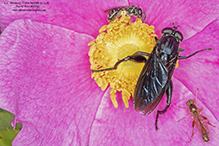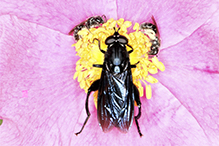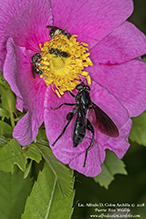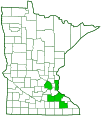Violet leafwalker
(Chalcosyrphus chalybeus)
Conservation • Description • Habitat • Ecology • Distribution • Taxonomy
Conservation Status |
|||
| IUCN Red List | not listed |
||
| NatureServe | not listed NNR - Unranked |
||
| Minnesota | not listed |
||
Description
Violet leafwalker is a large, wasp mimicking hoverfly. It is found in North America east of the Great Plains. It is said to be common but there are relatively few reported observations. This may be due to the appearance and behavior, both of which mimic blue mud wasps.
Adults are ½″ to ⅝″ in length.
The head is black with some white hairs. The face is concave. The female has white markings on the face. On the male the large compound eyes meet at the top of the head but before the three simple eyes (ocelli). The antennae are short and black. The third segment is wider and is longer than the remaining segments combined.
The upper side of the thorax is iridescent bluish-black and shiny. It may appear black, blue, or purple, depending on the angle of the light. It is covered with short black hairs and has some longer white hairs in the shoulder (humeral) area. The sides of the thorax are black. On the underside, the plate covering the last segment (metasternum), the segment bearing the hind legs, is covered with hairs.
The abdomen is metallic bluish-black to black and is covered with short black hairs.
The legs are completely black and are covered with short, bristly, black hairs. The third segment (femur) on the hind leg is large and flattened. The fourth segment (tibia) of the hind leg is slightly curved.
The wings are brownish-black and iridescent. In some light, they appear mostly blue with purple at the tip and along the inside margin.
Size
Total length: ½″ to ⅝″
Similar Species
Habitat
Damp forests and swamps
Ecology
Season
Late May to early August
Behavior
It flicks its wings when at rest, mimicking the behavior of a wasp.
Life Cycle
Larva Food/Hosts
Rotting dead wood
Adult Food
Flower nectar
Distribution |
||
|
Sources Telford, Horace S.. (1939). The Syrphidae of Minnesota. University of Minnesota. Minnesota Agricultural Experiment Station. |
|
| 9/25/2025 | ||
Occurrence |
||
Fairly common |
||
Taxonomy
Order
Suborder
Brachycera
Infraorder
Cyclorrhapha
Zoosection
Aschiza
Family
Syrphidae (Hover Flies)
Subfamily
Eristalinae (drone flies and allies)
Tribe
Milesiini
Subtribe
Xylotina
Genus
Chalcosyrphus (leafwalkers)
Subgenus
Xylotomima
Subordinate Taxa
Synonyms
Chalcosyrphus violascens
Heliophilus chalybea
Syrphus violascens
Xylota chalybea
Xylota purpurea
Xylotomima chalybea
Common Names
violet leafwalker
Glossary
Femur
On insects and arachnids, the third, largest, most robust segment of the leg, coming immediately before the tibia. On humans, the thigh bone.
Ocellus
Simple eye; an eye with a single lens. Plural: ocelli.
Tibia
The fourth segment of an insect leg, after the femur and before the tarsus (foot). The fifth segment of a spider leg or palp. Plural: tibiae.
Visitor Photos
Share your photo of this insect.
This button not working for you?
Simply email us at info@MinnesotaSeasons.com.
Attach one or more photos and, if you like, a caption.
Alfredo Colon |
||
... was flapping its wings like a wasp |
||
 |
 |
|
 |
||
MinnesotaSeasons.com Photos
|

Slideshows

Visitor Videos
Share your video of this insect.
This button not working for you?
Simply email us at info@MinnesotaSeasons.com.
Attach a video, a YouTube link, or a cloud storage link.
Other Videos



